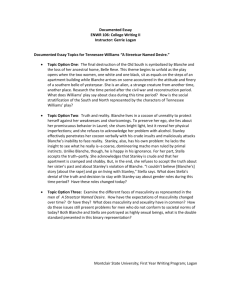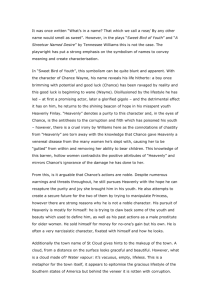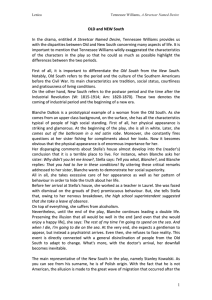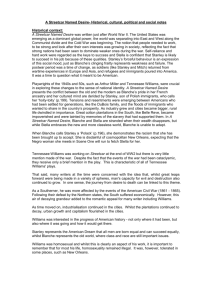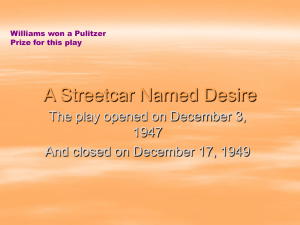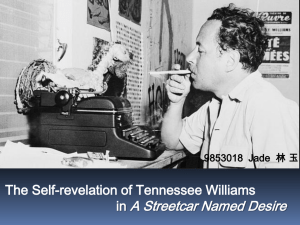12AP Eng
advertisement
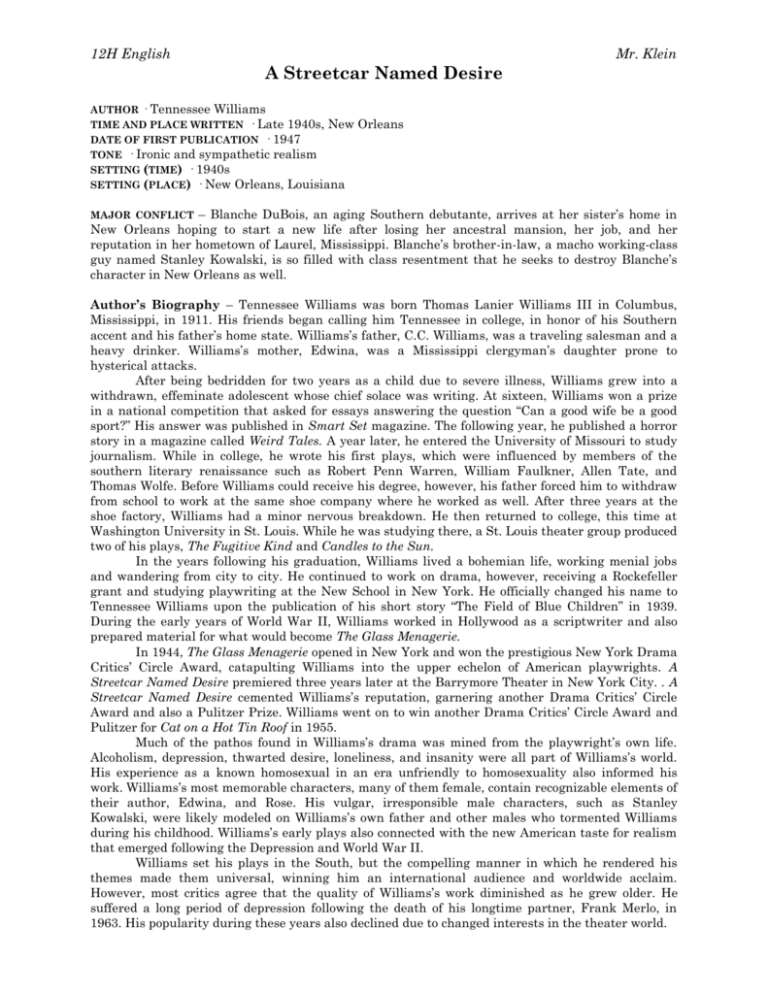
12H English Mr. Klein A Streetcar Named Desire AUTHOR · Tennessee Williams TIME AND PLACE WRITTEN · Late 1940s, DATE OF FIRST PUBLICATION · 1947 TONE · Ironic and sympathetic realism SETTING (TIME) · SETTING (PLACE) New Orleans 1940s · New Orleans, Louisiana – Blanche DuBois, an aging Southern debutante, arrives at her sister’s home in New Orleans hoping to start a new life after losing her ancestral mansion, her job, and her reputation in her hometown of Laurel, Mississippi. Blanche’s brother-in-law, a macho working-class guy named Stanley Kowalski, is so filled with class resentment that he seeks to destroy Blanche’s character in New Orleans as well. MAJOR CONFLICT Author’s Biography – Tennessee Williams was born Thomas Lanier Williams III in Columbus, Mississippi, in 1911. His friends began calling him Tennessee in college, in honor of his Southern accent and his father’s home state. Williams’s father, C.C. Williams, was a traveling salesman and a heavy drinker. Williams’s mother, Edwina, was a Mississippi clergyman’s daughter prone to hysterical attacks. After being bedridden for two years as a child due to severe illness, Williams grew into a withdrawn, effeminate adolescent whose chief solace was writing. At sixteen, Williams won a prize in a national competition that asked for essays answering the question “Can a good wife be a good sport?” His answer was published in Smart Set magazine. The following year, he published a horror story in a magazine called Weird Tales. A year later, he entered the University of Missouri to study journalism. While in college, he wrote his first plays, which were influenced by members of the southern literary renaissance such as Robert Penn Warren, William Faulkner, Allen Tate, and Thomas Wolfe. Before Williams could receive his degree, however, his father forced him to withdraw from school to work at the same shoe company where he worked as well. After three years at the shoe factory, Williams had a minor nervous breakdown. He then returned to college, this time at Washington University in St. Louis. While he was studying there, a St. Louis theater group produced two of his plays, The Fugitive Kind and Candles to the Sun. In the years following his graduation, Williams lived a bohemian life, working menial jobs and wandering from city to city. He continued to work on drama, however, receiving a Rockefeller grant and studying playwriting at the New School in New York. He officially changed his name to Tennessee Williams upon the publication of his short story “The Field of Blue Children” in 1939. During the early years of World War II, Williams worked in Hollywood as a scriptwriter and also prepared material for what would become The Glass Menagerie. In 1944, The Glass Menagerie opened in New York and won the prestigious New York Drama Critics’ Circle Award, catapulting Williams into the upper echelon of American playwrights. A Streetcar Named Desire premiered three years later at the Barrymore Theater in New York City. . A Streetcar Named Desire cemented Williams’s reputation, garnering another Drama Critics’ Circle Award and also a Pulitzer Prize. Williams went on to win another Drama Critics’ Circle Award and Pulitzer for Cat on a Hot Tin Roof in 1955. Much of the pathos found in Williams’s drama was mined from the playwright’s own life. Alcoholism, depression, thwarted desire, loneliness, and insanity were all part of Williams’s world. His experience as a known homosexual in an era unfriendly to homosexuality also informed his work. Williams’s most memorable characters, many of them female, contain recognizable elements of their author, Edwina, and Rose. His vulgar, irresponsible male characters, such as Stanley Kowalski, were likely modeled on Williams’s own father and other males who tormented Williams during his childhood. Williams’s early plays also connected with the new American taste for realism that emerged following the Depression and World War II. Williams set his plays in the South, but the compelling manner in which he rendered his themes made them universal, winning him an international audience and worldwide acclaim. However, most critics agree that the quality of Williams’s work diminished as he grew older. He suffered a long period of depression following the death of his longtime partner, Frank Merlo, in 1963. His popularity during these years also declined due to changed interests in the theater world. Williams died in 1983 when he choked on a medicine-bottle cap in an alcohol-related incident at the Elysée Hotel in New York City. He was one month short of his seventy-second birthday. In his long career he wrote twenty-five full-length plays (five made into movies), five screenplays, over seventy one-act plays, hundreds of short stories, two novels, poetry, and a memoir. The mark he left on the tradition of realism in American drama is indelible. Motifs – Motifs are recurring structures, contrasts, or literary devices that can help to develop and inform the text’s major themes. Light – Throughout the play, Blanche avoids appearing in direct, bright light, especially in front of her suitor, Mitch. She also refuses to reveal her age, and it is clear that she avoids light in order to prevent him from seeing the reality of her fading beauty. Bathing – Throughout A Streetcar Named Desire, Blanche bathes herself. Her sexual experiences have made her a hysterical woman, but these baths, as she says, calm her nerves. In light of her efforts to forget and shed her illicit past in the new community of New Orleans, these baths represent her efforts to cleanse herself of her odious history. Drunkenness – Both Stanley and Blanche drink excessively at various points during the play. Stanley’s drinking is social: he drinks with his friends at the bar, during their poker games, and to celebrate the birth of his child. Blanche’s drinking, on the other hand, is anti-social, and she tries to keep it a secret. She drinks on the sly in order to withdraw from harsh reality. Symbols – Symbols are objects, characters, figures, or colors used to represent abstract ideas or concepts. Shadows and Cries – As Blanche and Stanley begin to quarrel in Scene Ten, various oddly shaped shadows begin to appear on the wall behind her. Discordant noises and jungle cries also occur as Blanche begins to descend into madness. All of these effects combine to dramatize Blanche’s final breakdown and departure from reality in the face of Stanley’s physical threat. The Varsouviana Polka – The Varsouviana is the polka tune to which Blanche and her young husband, Allen Grey, were dancing when she last saw him alive. Earlier that day, she had walked in on him in bed with an older male friend. The polka music plays at various points in A Streetcar Named Desire, when Blanche is feeling remorse for Allen’s death. The polka and the moment it evokes represent Blanche’s loss of innocence. “It’s Only a Paper Moon” – In Scene Seven, Blanche sings this popular ballad while she bathes. The song’s lyrics describe the way love turns the world into a “phony” fantasy. These lyrics sum up Blanche’s approach to life. Meat – In Scene One, Stanley throws a package of meat at his adoring Stella for her to catch. The action sends Eunice and the Negro woman into peals of laughter. Presumably, they’ve picked up on the sexual innuendo behind Stanley’s gesture. Questions for Discussion 1. The plot of A Streetcar Named Desire is driven by the dueling personalities of Blanche and Stanley. What are the sources of their animosity toward one another? 2. Describe the use of light in the play. What does its presence or absence indicate? 3. How does Williams use sound as a dramatic device? 4. Compare and contrast Mitch to the other men in the play. 5. Compare and contrast Blanche and Stella.

